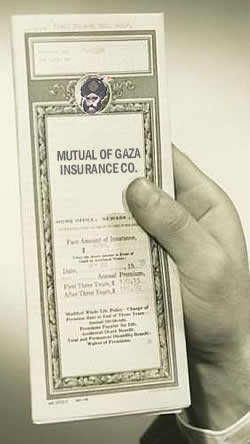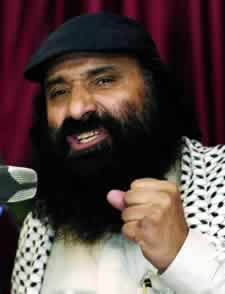Republicof Iran
...a theocratic Shiite state divided among the Medes, the Persians, and the (Arab) Elamites. Formerly a fairly civilized nation ruled by a Shah, it became a victim of Islamic revolution in 1979. The nation is today noted for
spontaneouslytaking over other countries' embassies, maintaining whorehouses run by clergymen, involvement in international drug trafficking, and financing sock puppet
militiasto extend the regime's influence. The word
Iranis a cognate form of
Aryan.The abbreviation
IRGCis the same idea as
Stürmabteilung (or SA).The term
Supreme Guideis a the modern version form of either
Duceor
Führeror maybe both. They hate
and its supreme leader, Ayatollah Ali Khamenei
...the very aged actual dictator of Iran, successor to Ayatollah Ruhollah Khomeini...>
, and pledging their commitment to Tehran’s objective of exporting the Islamic Revolution.
"From here, from Paleostine, from the Jenin Battalion, from the free and honorable people of Paleostine, we send our greetings to the Islamic Theocratic
Republicof Iran, to Imam Ali Khamenei, and we will soon establish the state of the Imam Mahdi," a masked gunman says in one of the videos.
That figure is mostly revered in the Shiite Islam that is practiced in Iran, and is less relevant to the Sunni Islam practiced in the Paleostinian territories, raising questions about the authenticity of the videos, with some critics of the PA claiming that the clips have been fabricated by the PA as part of its propaganda against rival factions.
Over the past days, Paleostinian Authority security forces have been engaged in a crackdown on terror groups in Jenin, and on Saturday killed the local leader of Paleostinian Islamic Jihad
...created after many members of the Egyptian Moslem Brotherhood decided the organization was becoming too moderate. Operations were conducted out of Egypt until 1981 when the group was exiled after the assassination of President Anwar Sadat. They worked out of Gaza until they were exiled to Lebanon in 1987, where they clove tightly to Hezbollah. In 1989 they moved to Damascus, where they remain a subsidiary of Hezbollah...
, Yazid Jaysa.
On Sunday, the US reportedly asked Israel to approve the urgent delivery of military assistance to the PA as it attempts to restore order in Jenin. Some have viewed the PA’s ongoing crackdown on armed factions in Jenin as an attempt by Ramallah to prove it can assert military control over West Bank territories under its jurisdiction, in preparation for a role it seeks to play in the future governance of the Gazoo
...Hellhole adjunct to Israel and Egypt's Sinai Peninsula, inhabited by Gazooks. The place was acquired in the wake of the 1967 War and then presented to Paleostinian control in 2006 by Ariel Sharon, who had entered his dotage. It is currently ruled with a rusty iron fist by Hamas with about the living conditions you'd expect. It periodically attacks the Hated Zionist Entity whenever Iran needs a ruckus created or the hard boyz get bored, getting thumped by the IDF in return. The ruling turbans then wave the bloody shirt and holler loudly about
oppressionand
disproportionate response...
Strip.
Since at least 2022, Iran has inundated the West Bank with arms, smuggling them across the border from Jordan to foment unrest with Israel, according to a report published in April by The New York Times

...which still proudly claims Walter Duranty's Pulitzer prize...
.
The Islamic Theocratic
Republichas long provided financial support to Hamas
 ..the well-beloved offspring of the Moslem Brotherhood,...
..the well-beloved offspring of the Moslem Brotherhood,...and the Paleostinian Islamic Jihad terror groups as part of its Axis of Resistance® against Israel, which has suffered heavy blows after the decimation of the military capabilities of Hamas and Hezbollah in Leb
...The Lebs maintain a precarious sectarian balance among Shiites, Sunnis, and about a dozen flavors of Christians, plus Armenians, Georgians, and who knows what else?...
and the fall of the Iran-backed Assad regime in Syria.o
313 by itself refers to the 313 men in Shia Twelvers belief that will rise to fight alongside elMahdi upon his reappearance -
— Mo Ghaoui (@moghaoui) December 16, 2024
There was a compilation video of their irgc supporting statements by YaffaNews, am attaching here: pic.twitter.com/ORxY7HZOFK
… That's what the PA raids and operation in Jenin are all about – the United States has asked Israel to approve a shipment of ammunition, vests, helmets, night vision equipment, small arms, and vehicles to PA forces who are woefully and inadequately equipped to fulfill this critical and dangerous task. Palestinians being in charge of their own security is a superior option to the Israeli military conducting raids and inflaming tensions that fuel a vicious cycle.
The IRGC has stood up ideological fighters who are repeating Shia religious slogans and explicitly praising Tehran, all while forming a highly suspicious fighting formation that they’re calling “Brigade 313” – a religiously-inspired name that has appeared in Syria, Iraq, and elsewhere. These are not “resistance” fighters as clueless “pro-Palestine” imbeciles are claiming: this is something entirely new and unprecedented. These are agents of chaos that the Islamic Republic is hoping will bring about the collapse of the PA and trigger a massive Israeli counterattack, which would trigger more violence in a desperate bid to save the destroyed “Axis of Resistance.”
The United States and its allies must do all that’s possible to empower the PA and its forces and allow for an organic counterterrorism operation against PIJ, Hamas, and other thugs and gangsters. This is an opportunity to demonstrate the efficacy of a Palestinian-led security architecture that serves the interests and needs of all, something that could be a framework for future security in the Gaza Strip.

 Acting under the establishment dictum, one of the most dangerous jehadi organizations operating from Pakistan and active in J&K, the JeM, restyled itself as the
Acting under the establishment dictum, one of the most dangerous jehadi organizations operating from Pakistan and active in J&K, the JeM, restyled itself as the  Led by Rawalpindi-based
Led by Rawalpindi-based